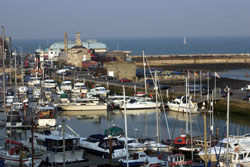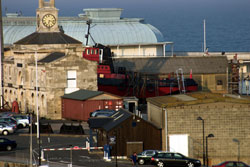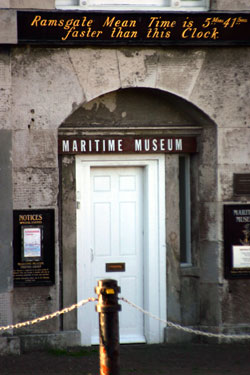Sigma 70-300mm F/4-5.6 DG Macro
This lens is one of two virtually identical offerings from Sigma in the extremely popular 70-300 category in which almost all manufacturers have at least one contender. In the budget sector, this one, the DG version, is the lesser of the two offerings, but we make no apologies for repeating ourselves as we take a look at what you get for your money.
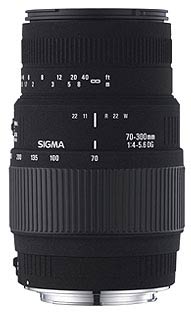 Specifications
Specifications
• Focal length 70-300mm
• Aperture f/4-5.6
• Angle of view 34.3-8.2°
• Filter size / type 58mm
• Construction Elements/groups 14 elements in 10 groups
• Focusing type Rotating & extending
• Closest focus 1.5m (0.95m in Macro mode 1:2)
• Weight 0.545kg
• Dimensions (Dia x length) 76.6x122mm
• Mounts available Sigma, Canon, Nikon, Minolta, Pentax
• Tripod bush No
• Price £149.99
Build and Handling
Physically identical to it’s more expensive, APO sister lens with the first 12mm given over to accommodate the AF/MF switch situated on the left of the barrel, the next third is occupied by the zoom ring which is marked at 70, 100, 135, 200 and 300mm. Although not hard to move, you do know you are moving a fair amount of glass as the front element travels forward some 55mm through the range.
The next part of the barrel has a basic depth-of-field scale marked and, again on the left, carries the switch to enable ‘Macro’ photography. The final 25% of the barrel forms the focus ring, which, in manual focus, is nicely torqued. Once switched to Autofocus, it cannot be over-ridden and becomes stiff for that reason. In normal mode, focussing can extend the lens a further 17mm.
One of the features of this lens is the ‘Macro’ mode, which allows photography to a ratio of 1:2. Not true Macro, but a useful feature just the same. It works between the focal lengths of 200-300mm and is engaged by sliding the switch once the lens is extended past 200mm. This allows the focus ring to travel further, extending the lens another 14mm, in order to focus closer. This brings the total extension, at 300mm and at the closest focus to some 86mm. At this length, more than half of the lens is rotating during focussing, which can be awkward to hold still. The AF performance is adequate for a lens in this price bracket. Not fast, but quick enough for most purposes and although the motor makes a noise, it is not so noisy as to scare off the target.
Optical Quality
This is the area where the two lenses differ, however the optical design is identical to the big sister lens, it is simply the materials used that are slightly less expensive. This lens still includes a single SLD (special low dispersion) element in its construction to help overcome chromatic aberration and this is a reasonable success, with no obvious fringing. Distortions are also reasonable, with just a slight pincushion effect at the long focal length. Resolution is not quite up to the level of the APO version, however, the upgrade to DG status does seem to have closed the gap a little. Results, especially close up, were quite pleasing at times.
The performance, as with most, if not this entire lens group, was better at the shorter end, beginning to trail off a touch as the focal length gets longer.
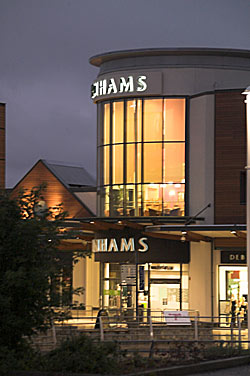 The lens is light enough to carry around with you all the time, even when out doing domestic chores! 1/100sec at f/8 and 70mm | 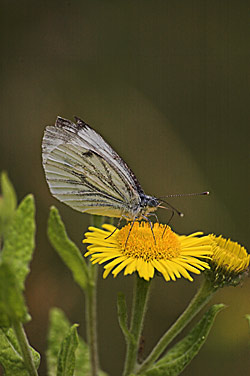 All shots taken on a Canon 1D, various settings between 200-300mm in Macro mode. |
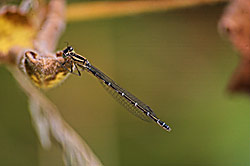 | Many insects are too big to photograph at 1:1, such as these shots of a butterfly, a damselfly and a dragonfly. Even if you could get close enough! The 1:2 facility of this lens is ideal, giving close focus ability below 1m between 200 and 300mm. This is true for both full frame as well as cropped sensors. |
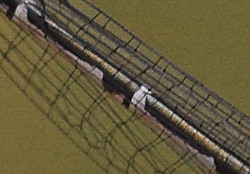 This 100% crop from the centre of the damselfly picture shows the detail the lens is capable of. | 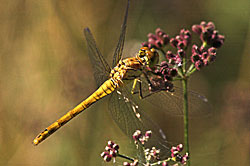 |
Click on each comparision photo below to view full size versions
Below is our lens test data. To find out how to use these graphs look at this article: How we test lenses
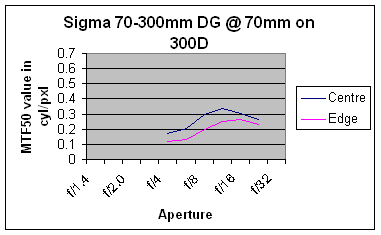
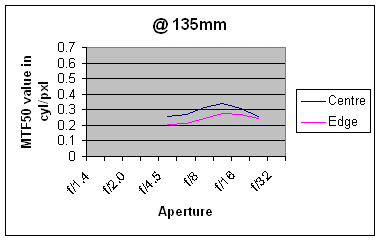
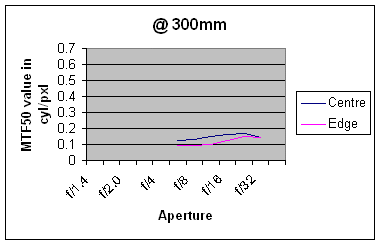
Verdict
For someone who is on a tight budget, this lens, having been upgraded to DG (digitally optimised) status, seems to have closed the gap slightly on its more expensive sister. The usefulness of the lens is greatly added to with its ability to focus down to less than a metre and anyone wishing to photograph large insects such as butterflies or dragonflies will find it a most useful lenses for this discipline, being light enough to carry on a neck strap all day with the focal length allowing the luxury of not needing to get too close. Many of these types of insect are too large for 1:1 photography in any case!
In summary the main positive points of the Sigma 70-300mm f/4-5.6 DG Macro are:
![]() Reasonable optical performance for price.
Reasonable optical performance for price.
![]() Good close focus ability (1:2)
Good close focus ability (1:2)
![]() Light enough to carry all day.
Light enough to carry all day.
![]() Price.
Price.
Negative points are:
![]() Long extension when close focussed and zoomed.
Long extension when close focussed and zoomed.
![]() Front element and extension rotates during focussing
Front element and extension rotates during focussing
![]() Performance drops off at longer focal lengths.
Performance drops off at longer focal lengths.
Check the latest price of the Sigma 70-300mm DG Macro here
Test by Ian Andrews www.wildaboutkent.co.uk
David Chamberlain
Add your message
Please login here or if you've not registered, you can register here. Registering is safe, quick and free.
photodo Stats
428 MTF tests
74 in-depth photodo reviews
100+ users join each day
Help the lens community by reviewing or rating a lens today via our lens search
Latest Lens Reviews
- Chinon 28mm f/2.8 Vintage Lens Review
- Canon EF 70-200mm f/4L IS II USM Lens Review
- Samyang AF 85mm f/1.4 EF Review
- Sigma 70mm f/2.8 DG Macro Art Review
- Samyang AF 24mm f/2.8 FE Review
- Meike 50mm f/1.7 Review
- Tamron 70-210mm f/4 Di VC USD Review
- Lensbaby Burnside 35mm f/2.8 Review
- Asahi Super Takumar 50mm f/1.4 Review
- Asahi Super-Multi-Coated Takumar 135mm f/3.5 Review
